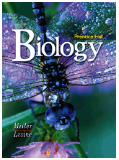BIOLOGY
by Miller & Levine
[complete Table of Contents]

|
Use the pull-down menu to jump to any of the Book's 40 Chapters: |
Additional Resources:

Understanding
Flowers
From the Backyard Nature web site.
Flowering
Plants
From the UC Berkeley Museum
![]() Chapter 24
Chapter 24 ![]()
Reproduction of Seed Plants
In this chapter, students will read about the sexual reproduction of seed plants and the natural and artificial asexual propagation of plants. The links below lead to additional resources to help you with this chapter. These include Hot Links to Web sites related to the topics in this chapter, the Take It to the Net activities referred to in your textbook, a Self-Test you can use to test your knowledge of this chapter, and Teaching Links that instructors may find useful for their students.
| Hot Links | |
| Take it to the Net | Teaching Links |
What are Web Codes? |
Web
Codes for Chapter 24: |
![]()
Section 24-1: Reproduction With Cones and Flowers
![]() Reproduction in gymnosperms takes place in cones, which are produced by
a mature sporophyte plant.
Reproduction in gymnosperms takes place in cones, which are produced by
a mature sporophyte plant.
 Flowers are reproductive organs that
are composed of four kinds of specialized leaves: sepals, petals, stamens,
and carpels.
Flowers are reproductive organs that
are composed of four kinds of specialized leaves: sepals, petals, stamens,
and carpels.
 Reproduction in angiosperms takes place
within the flower. Following pollination and fertilization, the seeds
develop inside protective structures called fruits.
Reproduction in angiosperms takes place
within the flower. Following pollination and fertilization, the seeds
develop inside protective structures called fruits.
 Most gymnosperms are wind pollinated,
whereas most flowering plants are pollinated by animals.
Most gymnosperms are wind pollinated,
whereas most flowering plants are pollinated by animals.
Section
24-2: Seed Development and Germination
 As angiosperm seeds mature, the ovary
walls thicken to form a fruit that encloses the developing seeds.
As angiosperm seeds mature, the ovary
walls thicken to form a fruit that encloses the developing seeds.
 Seeds dispersed by animals are typically
contained in fleshy, nutritious fruits.
Seeds dispersed by animals are typically
contained in fleshy, nutritious fruits.
 Seeds dispersed by wind or water are
typically lightweight, allowing them to be carried in the air or to float
on the surface of the water.
Seeds dispersed by wind or water are
typically lightweight, allowing them to be carried in the air or to float
on the surface of the water.
 Environmental factors such as temperature
and moisture can cause a seed to end dormancy and germinate.
Environmental factors such as temperature
and moisture can cause a seed to end dormancy and germinate.
Section
24-3: Plant Propagation and Agriculture
 Vegetative reproduction includes the
production of new plants from horizontal stems, cuttings, leaves, plantlets,
and underground roots.
Vegetative reproduction includes the
production of new plants from horizontal stems, cuttings, leaves, plantlets,
and underground roots.
 Horticulturists use plant propagation
to make many identical copies of a plant or to produce offspring from
seedless plants.
Horticulturists use plant propagation
to make many identical copies of a plant or to produce offspring from
seedless plants.
 Most of the people of the world depend
on a few crop plants, such as wheat, rice, and corn, for the bulk of their
food supply.
Most of the people of the world depend
on a few crop plants, such as wheat, rice, and corn, for the bulk of their
food supply.